This is a “long-read.” For those who prefer, download a PDF (3MB) copy here.
So Long, and Thanks For All the Fish1
It is a curious situation that the sea, from which life first arose, should now be threatened by the activities of one form of that life. But the sea, though changed in a sinister way, will continue to exist; the threat is rather to life itself.
Rachel Carson, The Sea Around Us

The ocean contains 97% of the planet’s water and covers 71% of the Earth’s surface. Stand on the shore and its expanse and distant horizon imply an endless source of resources. Now we recognize that the oceans are not boundless and the numbers of fish are not endless.
It wasn’t until the late 20th Century that we understood the world production (harvest) of fish is on a downward trend. And not only are the numbers of fish shrinking, the size of those fish is getting smaller too.
At what point do we stop readjusting downward? “Every generation will use the images they got at the beginning of their consciousness and will extrapolate forward,” says Dr. Daniel Pauly (Professor, Fisheries Centre & Zoology, UBC, Vancouver BC; Principal Investigator, Sea Around Us Project), “using their current experience as the baseline against which changes up or down are measured. They don’t consider previous loss or gain.” And yet, each time the baseline drops, we call it the new “normal.”

We are just beginning to understand that we may soon reach the end of the line – pun intended – for some of our “keystone” fish species: salmon, sea bass, cod, and tuna. Authors Paul Greenberg (Four Fish) and Daniel Pauly (Five Easy Pieces) have written excellent books telling us how – and why – we will be out of fish by the middle of this century unless we take some drastic steps.
Overview of Global Wild-Catch Fisheries
According to the FAO – Food and Agriculture Organization of the United Nations – the proportion of marine (ocean) fish stocks fished at biologically sustainable levels declined from 90% in 1974 to 71% in 2011. Of the fish stocks assessed in 2011, 61% were considered “fully fished” and only 10% were described as “under fished.”[2] That leaves 29% categorized as “over fished.”
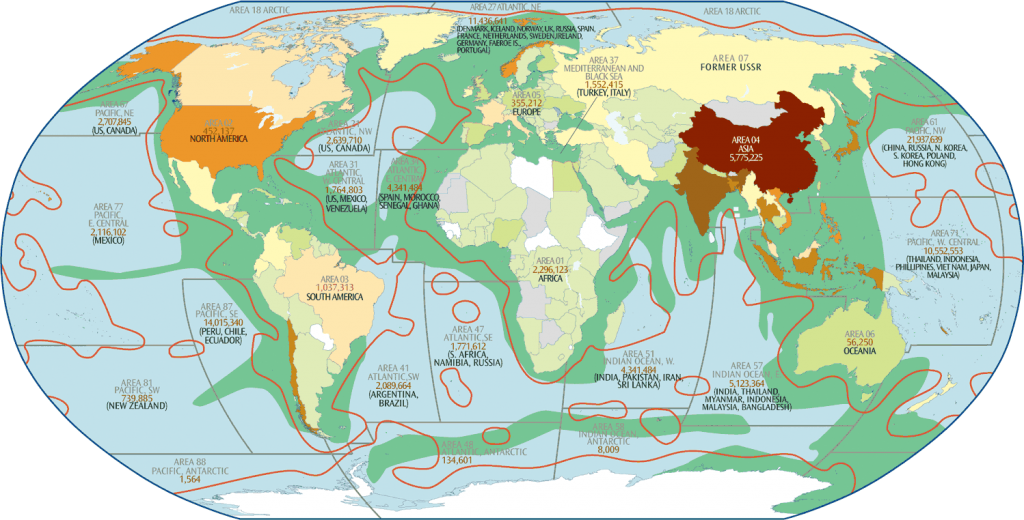
There are simply too many boats, too many fishermen, and too much fishing “power” – bigger boats, better technology – and the result is overfishing of almost all the world’s fisheries.[3] We’ve seen the price of some fish species increase as the weight of the fish caught drops.
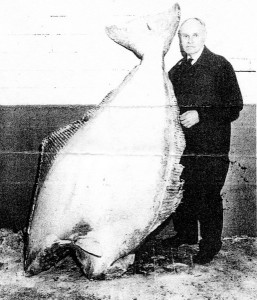 The price of Pacific salmon has stabilized as farmed Atlantic salmon replace wild caught fish. Today Norwegian-farmed Atlantic salmon wholesale for about $3 per pound and Chilean farmed salmon reached $5.40, while troll-caught Alaskan Chinook salmon caught during the winter season which closed in April 2014 sold at an average price of $5.69 per pound at the dock.[4]
The price of Pacific salmon has stabilized as farmed Atlantic salmon replace wild caught fish. Today Norwegian-farmed Atlantic salmon wholesale for about $3 per pound and Chilean farmed salmon reached $5.40, while troll-caught Alaskan Chinook salmon caught during the winter season which closed in April 2014 sold at an average price of $5.69 per pound at the dock.[4]
In 1974, an 8-foot long, 33-year-old female Pacific halibut weighing 375 pounds with its head and viscera removed, or 500 pounds live weight, was caught in the Bering Sea by Ralph Lund on the Schooner Thor. The fish sold for $.80 per pound, $300.[5]
Adjust that price for inflation and that fisherman would have gotten a dock price of $3.85 per pound, or $1443. Those 500-pound halibut rarely exist; in fact, 50-pound halibut are nearly gone too.
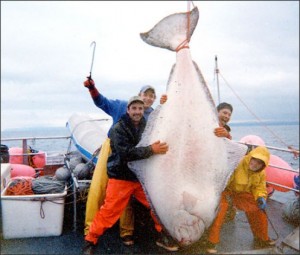 Nearly 30 years after Lund caught his behemoth, what might be the largest Pacific halibut ever documented – weighing 535 pounds – was pulled from the Bering Sea off St. Paul Island in September 2003, by the crew of the fishing boat Miss Mary.
Nearly 30 years after Lund caught his behemoth, what might be the largest Pacific halibut ever documented – weighing 535 pounds – was pulled from the Bering Sea off St. Paul Island in September 2003, by the crew of the fishing boat Miss Mary.
May 2014 market (fisherman’s) prices for Pacific halibut range from $6.50 per pound for 10/20-pound fish (smalls), $6.75 for 20/40-pound fish (mediums), and $6.90 for 40 pounds and up (large).[6] According to Jeff Berger, a manager at Copper River Seafoods, which buys fish at multiple ports in Alaska, the scarcity of large halibut makes the number meaningless: “There aren’t any, so you might as well throw that number away.”
What to do?
As we look at a world where many of the fisheries are poorly managed or even uncontrolled, the U.S. and the European Parliament are developing policies that will provide the means and incentives to reduce overfishing of depressed stocks.
Fisheries are primarily managed through the use of policies, licenses, permits, taxes, and fees. The two key areas of control are the number of fishermen and the fishing season (input controls) as well as the number, species, location, and timing of fish caught (output controls).
Since Alaska became a state, its fishing industry has been carefully managed for sustainability. In fact, sustainability is written into the state’s constitution:
Fish, forests, wildlife, grasslands, and all other replenishable resources belonging to the State shall be utilized, developed, and maintained on the sustained yield principal.
Alaska State Constitution, Article 8, January 3, 1959
Alaska’s legislation includes:
- Establishing open and closed seasons
- Setting quotas, bag limits, harvest limits, sex and size limitations
- Establishing the methods and means employed in the pursuit, capture, and transport of fish
- Watershed and habitat improvement, management, conservation, protection, use, disposal, propagation, and stocking of fish
- Regulating commercial, sport, guided sport, subsistence, and personal use fishing as needed for the conservation, development, and utilization of fisheries
The rest of the United States began to control fishing grounds off the coasts with the 1976 passage of the Magnuson-Stevens Act[7], which took aim at the overcapacity fueled by government subsidies to the American fishing fleet and the overfishing of depressed stocks. The most recent version of the Magnuson-Stevens Act was authorized in 2007.
In 2013, the European Parliament, under pressure from consumers, environmental organizations, and maritime scientists, adopted a series of measures that could, if implemented, have similar positive results. [8]
Governments around the world recognize that Illegal, unreported, and unregulated (IUU) fishing is a major threat to marine ecosystems, and agencies remain concerned about the amount of bycatch and discard in fisheries.
Balanced Harvest and Eco-system Management
Agro-ecology – applying eco-system management to farmland – has been implemented for decades and is proving to be very successful. Bringing eco-system management to fisheries is a relatively new concept, implemented under the name “balanced harvest.” It considers the impacts of fishing on larger fish and species of higher economic value – usually higher in the trophic pyramid.
Conventional fisheries management strategies based on selective fishing practices by species or using minimum mesh size in nets to release immature fish appear to contribute to changes in the marine food structure, and a loss of overall productivity and resilience of the aquatic ecosystem. These strategies may also be driving physical changes in fish that result in faster growth, earlier maturity, and lower maximum size.
A balanced harvest strategy is managed through the use of strict regulation and as a result costs more and requires more labor, making it difficult and costly to implement. There has, of course, been major push back because the strategy is seen as potentially undermining regulations that are enshrined in most fisheries legislation worldwide.
There is consensus globally that it is no longer enough to focus on the sustainability of target species and that broader ecosystem impacts of fishing have to be considered too. The real problem is identifying practical and cost-effective management strategies that will balance the desired result against social and economic impacts.
As we are seeing in agricultural systems around the world, the application of agro-ecology requires farmers to work with ecosystems to maintain biodiversity and insure the productivity, stability, and sustainability of the farm and the equitability of the farming community. Fishery researchers envision the application of balanced harvest strategies in global fisheries will reflect those same goals.[9]
Bycatch – Who’s Counting?
If you ran a company that regularly had a “waste rate” of 40%, you might want to get into another business! Waste in manufacturing is lost revenue, increased cost, and results from systematic inefficiencies.
Depending on the target species and the kind of equipment, the world’s fisheries have waste – “undesired marine life” caught by lines and nets while harvesting the desired species – that can exceed 2/3 of the catch. The “waste” can be made up of marine animals like turtles, whales, and dolphins caught by mistake or the millions of pounds of highly prized fish like halibut or cod that are tossed overboard when fishermen have already reached their quota and cannot bring more to shore.[10]
Some Useful Definitions:
CATCH: All fish that are caught, including targeted fish that are kept, non-targeted fish that are discarded, and non-target catch that fishermen bring to port.
BYCATCH: All incidental catch of non-target fish and ocean wildlife, often discarded at sea.
LANDINGS: All fish that are brought to port.
DISCARD RATE: A common metric to evaluate bycatch, calculated as the fishery’s total discards divided by its total catch (e.g., 1 pound discarded for every 5 pounds caught = 1/5 = 20% discard rate).
Working backwards from a global fishing harvest of more than 80 million metric tons of wild caught fish worldwide, we can estimate that the actual catch was more than 133 million metric tons, assuming a 40% discard rate. Bycatch can sometimes dwarf the desired harvest for a given species; in one extreme example, wild shrimp can come at a cost of 62 pounds of bycatch per pound of shrimp.[11]
Oceana, the largest international organization focused solely on ocean conservation, identified nine of the worst bycatch fisheries in the U.S. — fisheries that discard large amounts of fish or harm marine wildlife at a high rate. Several of these fisheries discard more fish than they keep, or discard large amounts of the very species they are aiming to catch.
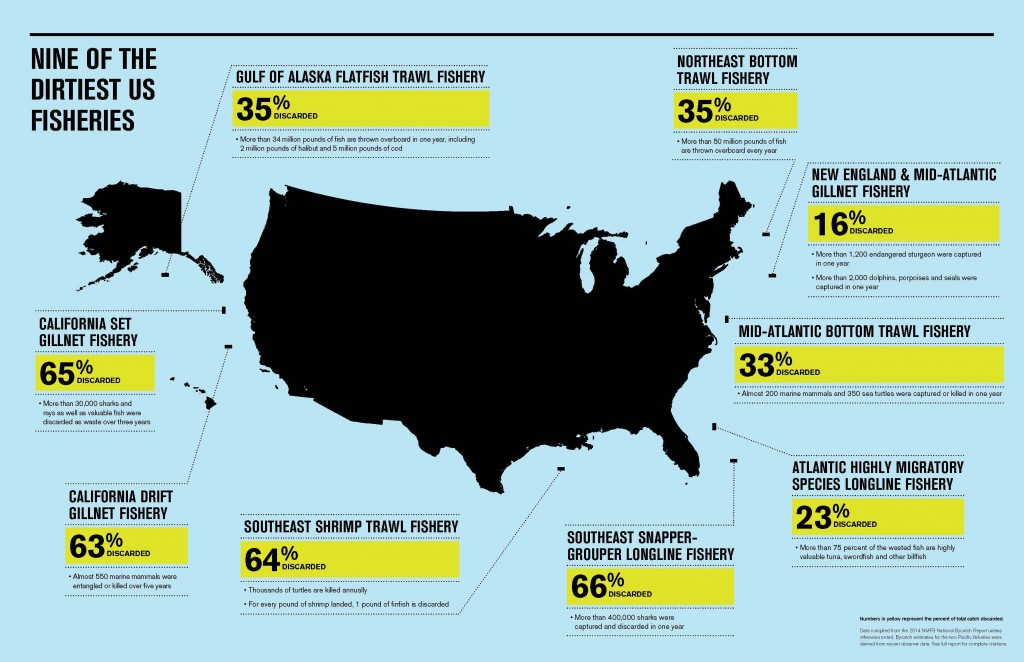
.
.
.
.
.
.
.
.
.
.
.
.
.
.
.
.
.
.
.
.
.
.
.
.
.
.
.
.
No industry can survive if nearly half of all its production is discarded.
Solutions to the bycatch problem already exist: employ adequate monitoring, count everything that is caught, establish science-based bycatch limits, and use innovative measures to control the problem. In order to stop harmful bycatch and wasteful discarding, fisheries managers and fishermen must apply these solutions nationally and internationally.
Fish Farming – On Land or By Sea
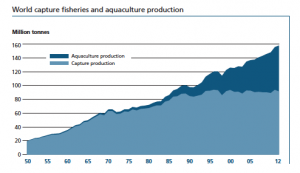
Source: The State of the World Fisheries and Aquaculture, FAO (2014)
Aquaculture – raising fish in captivity or “fish farming” – is the fastest growing source of fish protein in the world and is rapidly approaching half of all fish production; about 25% of all aquaculture production takes place in marine waters.
Fifteen main producer countries accounted for almost 93% of all farmed food fish production in 2012. China is by far the largest producer of farmed fish in the world, delivering 41 million metric tons of fish – nearly 62% of the world’s production – about 3% of which is grown in marine waters.
Aquaculture – especially inland, freshwater fish farms – can help feed the world’s population. Millions of people in developing countries depend on fish farmed in inland waters, and growing aquaculture production has increased the world’s per capita consumption of fish from 9.9 kg in the 1960s to 19.2 kg in 2012. In 2010, fish accounted for 16.7% of the global population’s intake of animal protein and 6.5% of all protein consumed.
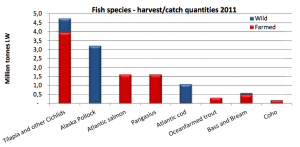
Source: Salmon Farming Industry Handbook, Marine Harvest Group (producers of farmed Atlantic salmon), 2013
While fish farming is an increasing source of protein for the world, much of the growth in aquaculture is in Asia where less attention is paid to the environmental effects and more to simply increasing production.
The growth of marine aquaculture – especially open ocean aquaculture – brings with it the same problems that confined animal feeding operations (CAFOs) do on dry land. Offshore fish farms are raised in giant cages located about 30 feet under water, up to 200 miles off the coast.
There has been much written about the health of feed-lot raised beef and, for the first time, research is proving that fish farms are causing similar degradation of animal health in fish. Fish farms ARE feed lots, farmed fish are NOT the same as wild fish, in the same way that feedlot grain-fed cattle are NOT the same as pastured grass-fed cattle.
Open ocean fish farms use netted cages or pens which can allow some fish to escape, and potentially spread disease, disrupt natural ecosystems, and breed with native or endangered species. Confinement operations – whether marine or terrestrial – concentrate waste and pollute water and air.
Water flowing out of an aquaculture facility can carry excessive nutrients, particulates, bacteria, other diseased organisms, and polluting chemicals. Feed and fecal matter from fish farms can deplete the dissolved oxygen concentrations within and around the site. Anti-fouling agents used to keep cages/pens clean are highly toxic. Large amounts of antibiotics are used to keep confined fish healthy and to encourage rapid growth. All of these can harm surrounding habitats, displace natural aquatic eco-systems, cause algal blooms, poison ocean wildlife, and lead to other severe disturbances.[12]
Salmon leukemia virus raged through fish farms in British Columbia in the early 1990s when the farms were first introduced. A retrovirus, salmon leukemia virus attacks the salmon’s immune system, so it dies of something else, much like the process of AIDS. At the time, it was discovered that virtually all the BC Chinook salmon farms were infected, and the virus killed 100% of the wild sockeye salmon exposed to it.
Genetic Engineering: A Non-Solution?
Is genetic engineering the solution? According to the Center for Food Safety, at least 35 species of fish are currently being genetically engineered around the world, including trout, catfish, tilapia, striped bass, flounder, and many species of salmon.
The purpose? To make them perfect candidates for CAFO-style fish farms. They are “designed” to grow faster with larger muscles, resist diseases, and tolerate higher temperatures. The genes introduced into these fish come not only from other fish, but also from coral, mice, bacteria, and even humans.
Actually, we should be clearer on the purpose. It’s not just to make the fish more “farm suitable,” it’s to make more money for the people growing and marketing GE fish – the industrial fish farmers. And, of course, the companies holding the patents on the technology.

How does all this work? AquaBounty Technologies, the Boston-based company seeking approval of a genetically engineered salmon, inserts DNA from another salmon species and the eel pout into the genome of an Atlantic salmon. The new genes make the salmon produce growth hormone all the time instead of just for three months each year as they normally would. They grow to market size in just over half the time it takes for Atlantic salmon, 16 to 18 months instead of 30.
While no genetically engineered animal has been approved by the Food and Drug Administration, scientists from several African countries are collaborating with U.S. aquaculturists to develop GE tilapia that will grow quickly and growth enhanced fish are being developed in Cuba.[13]
While AquaBounty has been trying to get approval to market their GE salmon since 1993, the FDA has not yet approved its sale. And to date 65 supermarkets, including Whole Foods, Safeway, and Trader Joe’s, along with seven seafood companies and restaurants, have signed a pledge not to carry it.
Know Where Your Fish Comes From: Seafood Traceability
We can’t trust what we’re eating. Consumers are presented with fish that has been mislabeled – accidentally or intentionally – or sold through illegal or unregulated channels.[14]
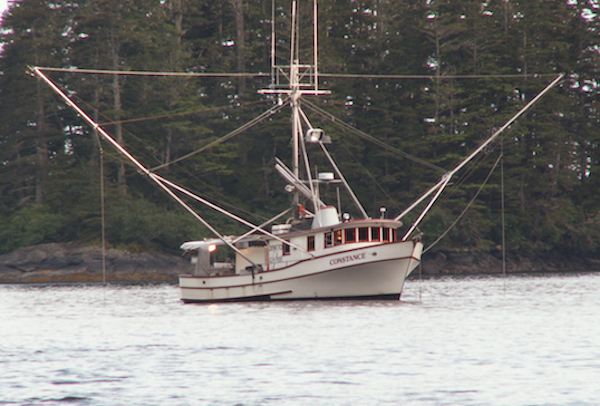
Fishing Vessel Constance, Sitka AK
When you look down at your plate, it’s pretty easy to tell the peas from the corn, and the squash from the potatoes. And, not many people have trouble telling chicken from beef when it has been cooked and served. Could you tell what kind of fish is on your plate?
More than 86% of all seafood consumed in the U.S. is imported[15] and there are more than 1,700 different species of seafood from all over the world now available for sale. So many look alike that we have to accept that the label or menu listing has got it right.
It turns out our trust has been abused and Oceana, an international organization working to protect the world’s oceans, is focused on product identity and tracks labeling fraud in supermarkets and restaurants. Recent studies have found that seafood may be mislabeled as often as 25% to 70% of the time for fish like red snapper, wild salmon, and Atlantic cod, disguising species that are less desirable, cheaper, or more readily available.[16]
Add to that the illegal, unregulated, and unreported (IUU) fish caught and sold illegally every year. A just-published report from the University of British Columbia estimates that up to 26% of all wild seafood imports to the U.S. is so-called “pirate fish.”[17]
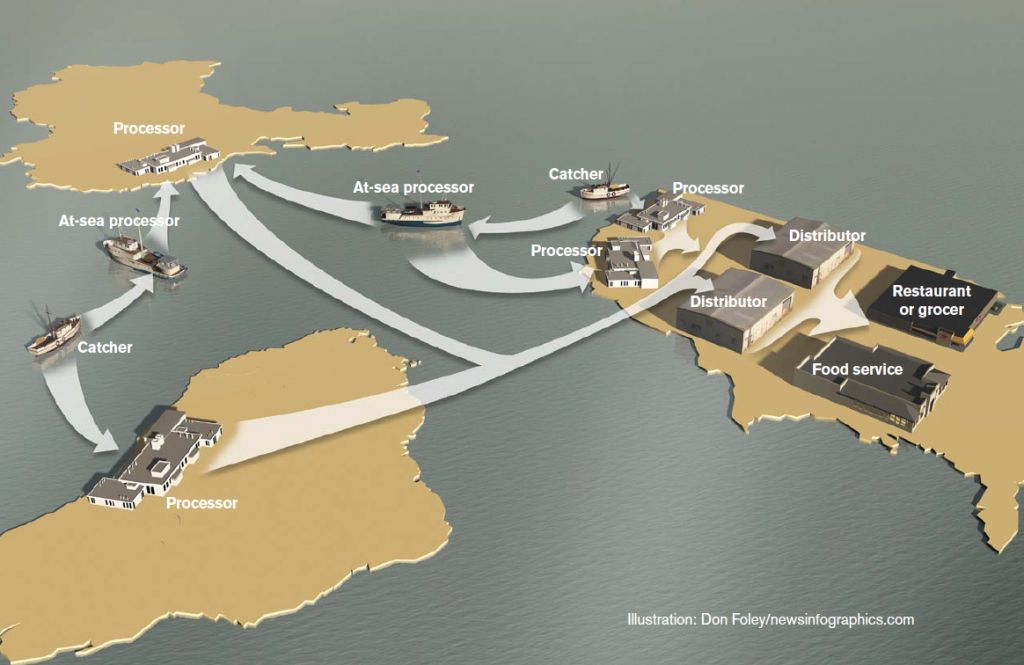
Tracking fish through the supply chain has become more and more difficult as globalization has transformed the fish-processing system. Fish processing is becoming more centralized and concentrated geographically, and is more vertically integrated with global supply chains. The link between producers and processors is tightly integrated to expand product offerings, achieve better yield and better importer quality, and meet food safety requirements.
And ever-increasing labor costs have led to outsourced fish processing, and a growing number of countries are providing those services. For example, in Europe, smoked and marinated products, for which shelf life and transportation time are important, are processed in Central and Eastern Europe.
Whole frozen fish from European and North American markets are sent to Asia (to China in particular, but also other countries such as India, Indonesia, and Viet Nam) for filleting and packaging, and then re-imported. Northwest salmon are being sent to China for processing, making an 8,000 mile round trip.[18]
Since 2005 when the U.S. Department of Agriculture established the rules, supermarket fish has been labeled with a “Country of Origin Label” (COOL), which requires seafood to bear a label that identifies where it is from and whether it was farm-raised or wild -caught. Processed seafood and seafood sold in restaurants and specialty seafood stores are exempt from COOL requirements. So unless you buy your seafood from a supermarket and prepare it yourself, you may never know its source.
What can you do? Buy direct from the fisherman, purchase “identity preserved” fish like Copper River salmon, or Bruce Gore Frozen-at-Sea® products, or buy fish with the Marine Stewardship Council (MSC) certification, and you can buy with some confidence that what you see is indeed what you get.
The MSC label is only displayed on seafood from an MSC-certified sustainable fishery, and any company selling or handling an MSC-certified product must also have MSC Chain of Custody certification, which insures that the fish is properly caught, labeled, and tracked through the supply chain.
An alternative to MSC certification and to provide credible verification of what Alaska has been doing for over fifty years, the Alaska Seafood Marketing Institute (ASMI) began, in 2011, offering independent, third-party certification of the management of the major Alaska commercial fisheries: FAO-Based Responsible Fisheries Management (RFM) Certification.
The certification is directly based on the respected United Nations Food and Agriculture Organization (FAO) Code of Conduct for Responsible Fisheries and the FAO Guidelines for the Ecolabelling of Fish and Fishery Products from Marine Capture Fisheries – both recognized around the globe as the best criteria for responsible fisheries management. RFM certification does not change the way the fisheries in Alaska themselves are managed; it just provides the independent assurance that the fisheries are being responsibly managed.
Conclusion
Fish is a critically important protein source around the world and we need to protect the heavily fished wild stocks as well as carefully manage fish farms to prevent disease, pollution, and genetic contamination.
Finfish and shellfish are big business in Washington; in 2006, the annual “economic value” of commercial, tribal, and recreational fishing in Washington (including shellfish) reached $3.9 billion. The economic value includes “first sale” of catches, wages and personal income, and the multiplier effect from downstream spending after direct earnings are spent within the state.[19]
The fishery eco-system includes the ocean, the atmosphere, the surrounding landscape, the fish and the food they eat, the fishermen who harvest them, the handlers who process the fish, the retailers who sell them, the chefs who cook them, and the consumers who eat them. Fish and fisheries are not separate from their eco-systems and environment and must be managed as a whole.
We cannot destroy river and stream habitats by clear-cutting and expect andromadus fish like salmon to flourish. We can’t pollute shorelines with agricultural and industrial runoff and expect mollusks – clams, oysters, and mussels – to be healthy and vigorous. We can’t dump waste in the ocean or the atmosphere until climate change raises both the water temperature and pH, and destroys both habitat and food sources for finfish and shellfish.
In the face of accelerating climate change, we may need to take more comprehensive steps – to eat less fish, eat a more diverse and local diet of mostly plant-based foods and small amounts of meat and fish, and restore our local fisheries, ensuring their long-term sustainability.
As a society, we need to accept the trade-off between short-term profits in the extractive industries and unbridled urban development and rebuild long-term resiliency back into what remains of our natural ecosystems. In Puget Sound, that means cleaning up the Sound and restoring our local watersheds.
Coming Next
As part of the GoodFood World series on fish and fisheries, we will next present an analysis of Puget Sound salmon: the “business” of the salmon fishery, the local fishery ecosystem, threats to salmon and their habitat, and the cultural importance of salmon to Pacific Northwest tribes.
Following our analysis we will then profile several small boat fishermen – tribal and commercial fishermen and women – living as far north as Sitka Alaska, telling their stories and hearing from them what fishing means to their families and communities.
Republished: August 11, 2015
Endnotes
[1] So Long and Thanks For All the Fish, Douglas Adams (Del Rey, 1999)
[2] The State of World Fisheries and Aquaculture 2014, Food and Agriculture Organization of the United Nations (FAO), http://www.fao.org/fishery/sofia/en
[3] Fish, Markets, and Fishermen: The Economics of Overfishing, Suzanne Iudicello, Michael Weber, and Robert Wieland, Island Press (1999)
[4] Salmon Fishery Update, Alaska Department of Fish and Game, May 16, 2014, http://www.adfg.alaska.gov/index.cfm?adfg=commercialbyareasoutheast.salmonfishery_updates
[5] The Pacific Halibut: Biology, Fishery, and Management, The International Pacific Halibut Commission (1987), http://www.iphc.int/publications/techrep/tech0022.pdf
[6] Dock prices up for halibut, salmon, Cristy Fry, Homer [AK] News, May 14, 2014, http://homernews.com/homer-news/business/2014-05-14/dock-prices-up-for-halibut-salmon
[7] Magnuson–Stevens Fishery Conservation and Management Act, Wikipedia, http://en.wikipedia.org/wiki/Magnuson%E2%80%93Stevens_Fishery_Conservation_and_Management_Act
[8] Fishing More, Catching Less, Daniel Pauly, March 26, 2014, New York Times, http://www.nytimes.com/2014/03/27/opinion/fishing-more-catching-less.html
[9] Selective fishing and balanced harvest in relation to fisheries and ecosystem sustainability, Serge Garcia, et al, International Union for Conservation of Nature, 2011, https://portals.iucn.org/library/node/9778
[10] Wasted Catch: Unsolved Problems In U.S. Fisheries, Amanda Keledjian, et al, Oceana, March 2014, http://oceana.org/en/news-media/publications/reports/wasted-catch-unsolved-problems-in-us-fisheries
[11] Can We Stop Overfishing Before It’s Too Late?, Eric Justian, March 14th, 2014, Triple Pundit, http://www.triplepundit.com/2014/03/can-stop-overfishing-late/
[12] Top 10 Problems of Offshore Fish Farms, Food and Water Watch, http://www.foodandwaterwatch.org/common-resources/fish/fish-farming/offshore/problems/
[13] Genetically Engineered Animals, U.S. Food and Drug Administration, http://www.fda.gov/AnimalVeterinary/DevelopmentApprovalProcess/GeneticEngineering/GeneticallyEngineeredAnimals/ucm113605.htm
[14] Seafood Traceability: The Business Case for Better Data, April 9th, 2014, Triple Pundit, http://www.triplepundit.com/2014/04/seafood-traceability-business-case-better-data/
[15] Wild-Caught Seafood: Outside the US, NOAA Fish Watch, http://www.fishwatch.gov/wild_seafood/outside_the_us.htm
[16] Bait and Switch: How Seafood Fraud Hurts Our Oceans, Our Wallets, and Our Health, Authors: Margot L. Stiles, Heather Lahr, William Lahey, Emily Shaftel, David Bethel, Justin Falls, Michael F. Hirshfield, Oceana, 2011, http://oceana.org/en/news-media/publications/reports/bait-and-switch-how-seafood-fraud-hurts-our-oceans-our-wallets-and-our-health
[17] Estimates of illegal and unreported fish in seafood imports to the USA, Ganapathiraju Pramod, Marine Policy, September 2014, http://www.sciencedirect.com/science/article/pii/S0308597X14000918
[18] NW salmon sent to China before reaching U.S. Tables, Choy Leng Yeong, July 16, 2005, The Seattle Times, http://seattletimes.com/html/businesstechnology/2002384544_uschinafish16.html
[19] Washington State Commercial Fishing Industry Total Economic Contribution prepared for Seattle Marine Business Coalition, Hans D. Radtke, Ph.D., January 2011, http://www.philipspublishing.com/smbc/attachments/SMBC%20Washington%20Total%20Commercial%20Fisheries%204.pdf

Greetings,
FYI, Triad Fisheries is no longer part of the MSC program. Triad Fisheries was the first company certified under ASMI’s Responsible Fisheries Management Program, RFM. Our certification number is COCALA111.
Thanks very much,
Mark Tupper
Mark,
Thanks for the update!
The ASMI certification is an alternative to MSC certification and it validates only Alaskan fisheries.
Hope you have a great season!
Gail N-K
GoodFood World